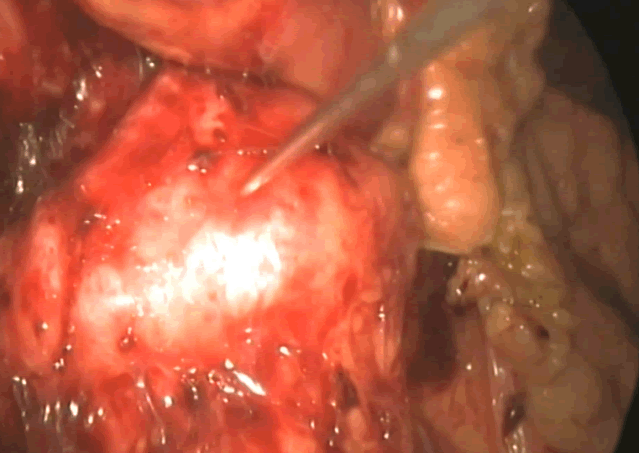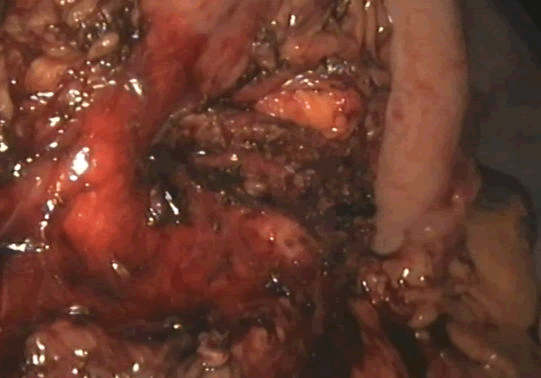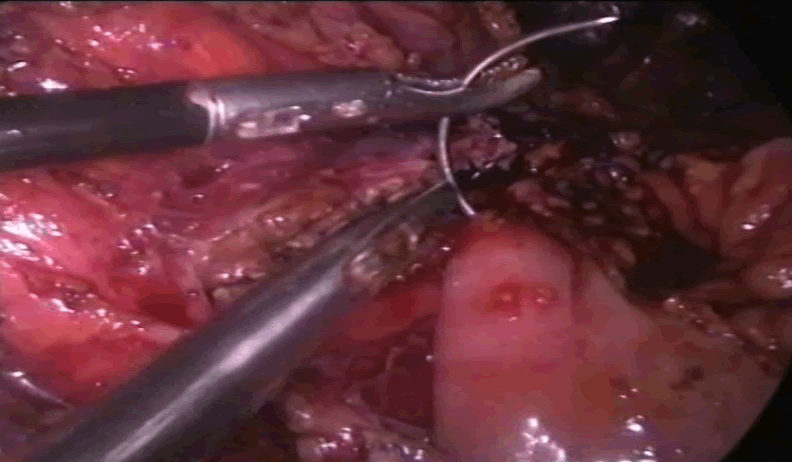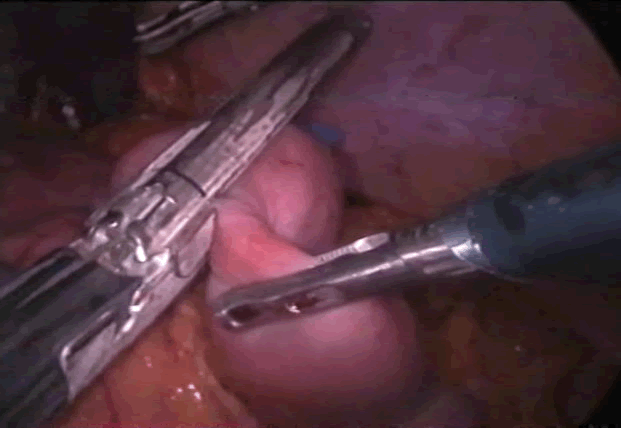Iurii Mikheiev*
Department of Surgery and Minimally Invasive Technologies, SI, Zaporizhia Medical Academy of Post-Graduate Education Ministry of Health of Ukraine, Ukraine
*Corresponding author: Iurii Mikheiev, Assistant Professor, Department of Surgery and Minimally Invasive Technologies, SI (Zaporizhia Medical Academy of Post-Graduate Education Ministry of Health of Ukraine), Vintera boulevard 20, Zaporizhia, 69096, Ukraine, Tel: +380973940849; E-mail: mikheev.u.a@gmail.com
Received date: July 7, 2020; Accepted date: August 18, 2021; Published date: August 28, 2021
Citation:Iurii M (2021) Laparoscopic Lateral Pancreatojejunostomy for Chronic Pancreatitis. J Clin Gastroenterol Hepatol Vol.4. No.4.
Surgery is a more effective option for pain relief in chronic pancreatitis. It relates to those patients who don't have an increase in the head of the pancreas, and there is only dilatation of the main pancreatic duct, a good results can give the performance of laparoscopic lateral pancreatojejunostomy.
Materials and Methods
Four attempts of laparoscopic lateral pancreatojejunostomy were made in patients with early chronic pancreatitis without an increase in the head of the pancreas. There were two females and two men and average age was 42,6. The indications for surgery in all patients was abdominal pain and dilatation main pancreatic duct (the average diameter was 12,8 mm). We used five-port technique. After opening omental bursa, we found, punctured and opened the main pancreatic duct. Then, using a two linear staplers Endo-Gia 60 to handle the jejunum loops by Roux-en-Y. We we performed single-row longitudinal pancreatojejunostomy with barbed-suture V-Loc.
Results. We had two conversion to open surgery, because of theinability to find the main pancreatic duct and bleeding. The average operation time was 207 minutes. Post-operative stay was average 9 days and on median follow-up of 12 month. Post-operatively, there were no major morbidity and nil mortality. All patients had complete pain relief and significant weight gain.
Conclusions. Laparoscopic longitudinal pancreaticojejunostomy is safe, effective and feasible, especially with "early chronic pancreatitis" without an increase in the head of the pancreas.
Keywords: chronic pancreatitis, laparoscopic lateral pancreaticojejunostomy
Introduction
Chronic pancreatitis (CP) is a disease of the pancreas in which recurrent inflammatory episodes result in replacement of the pancreatic parenchyma by fibrous connective tissue. This fibrotic reorganisation of the pancreas leads to progressive exocrine and endocrine pancreatic insufficiency [1]. Patients with End Stage CP typically struggle with pain relief, stigmatization, unemployment, and depression and often have among the worst quality of life measures for any chronic disease [2]. Progression of CP an increased risk of pancreatic cancer [3]. Almost all treatment options for CP aim to combatÃÂõ pain, and only surgical interventions that have more pronounced and long lasting effect compared with, for example, endoscopic interventions, are most effective [1, 4].
Laparoscopic surgical procedures today due to technological progress are actively used and implemented in pancreatic surgery, but their use in CP remains insufficient. The first report on the successful implementation of laparoscopic lateral pancreatojejunostomy (LLPJS) was made by Kurian and Gagner in 1999 [5]. Today there is a small number of reports on the successful implementation of the LLPJS, with the largest number of operations 12 and 17 among two surgeons [6, 7]. The number of LLPJS performed in other surgeons, according to these publications by 2015, together did not exceed 50 operations [8, 9, 10, 11]. But assessments of the relevance and feasibility of LLPJS are limited by an abundance of publications and very controversial among known pancreatic surgeons.
Materials and methods. For the period 2016-2018, four attempts were made by the LLPJS on the basis of the Department of Surgery and Minimally Invasive Technologies, which was 16% among all patients with CP operated during this time. Among them were two women and two men, the average age was 42,6 years. Inclusion criteria were patients with CP disease without enlargement of the head of pancreas and dilatation of the main pancreatic duct over 10 mm (mean diameter 12,8 mm) and the presence of concernments only in its lumen, without biliary and portal hypertension.
Surgical technique. Position of the patient on the operating table on the back with dilated legs. The operating surgeon was located from the beginning between the legs of the patient, the assistants are on the right and on the left, then at the stage of formation of pancreatojejunoanastomosis on the right, and the cameramen is between the legs of the patient. The inclination angle of the operating table during the operation was changed for greater convenience of the surgical team and better access to the area of interest. The first trocar is set slightly below the navel after reaching the pressure in the abdominal cavity 12-14 mm Hg. In addition, two troacar mounted on the right and one or two to the left of the navel were additionally fanciful.
Figure 1: Puncture of the main pancreatic duct.
Figure 2: Appearance of the main pancreatic duct (indicated by an arrow).
Concrements were removed from the main pancreatic duct. Using the stapler, Endo GIA 60 (blue cassette) the small intestine at a distance of 20 cm from the ligament of Treitz (Fig. 3) was intersected, and its detachable part was carried through a hole in the mescolon to the pancreas. With the help of barbed suture V-lok 2-0 length of 30 cm we formed longitudinal pancreatojejunoanastomosis with a single-row continuous suture (Fig. 4).
Figure 3: Intersection of the small bowel stapler Endo GIA 60.
Figure 4: Formation of laparoscopic lateral pancreatojejunoanastomosis
At the expense of the Stapler, Endo GIA 60 (blue cassette) was formed by jejunojejunostomy (Roux-loop), the hole after the stapler was sutured with a single-row suture V-lok 2-0 15 cm. For all patients cholecystectomy with separate clumping of the bladder duct and artery was performed. The operation was completed by drainage of the abdominal cavity and sewing of the ports.
Results
The table shows the results of operations (Table 1).
Table 1: Results of laparoscopic lateral pancreatojejunoanastomosis
| Number of patients |
4 |
| Successful total LLPJS |
2 |
| Conversion |
2 |
| Duration of operation |
175 and 240min |
| Intraoperative blood loss |
50 and 120 ml |
| Mortality |
- |
| Complications |
1 (grade II by Clavien-Dindo) |
| Duration of stay in hospital |
7 and 15 days |
| Follow-up |
20 and 10 months. |
With four attempts, the total laparoscopic operation was performed in 2 patients. In 2 patients, a conversion was made: in one case, due to uncontrolled bleeding from the pancreas, in the other - because of the inability to find the main pancreatic duct. It is possible to avoid conversion by using intraoperative ultrasound. The average transaction time was 207 minutes. The post-operative stay was an average of 9 days, and the average follow-up observation period was 15 months. One patient was observed to have a flow of bile by drainage up to 4 days, which spontaneously stopped. There were no pancreatic fistulas and fatal cases. All patients in the long-term outcome noticed pain disappearance and weight gain. According to the questionnaires SF-36 and EORTC BCH there was a significant improvement on functional scales, one patient even became pregnant and gave birth to a child.
Discussion
Until recently it was believed that lateral pancreatic pancreatojejunoanastomosis was emerged from the arsenal of surgical operations in the ÃÂáP due to a high percentage (up to 15-40%) of unsatisfactory results, the spread of duodenum-preserving resection of the pancreas and the emergence of other mechanisms for explaining pain other than central pancreatic duct hypertension [12].
But there is a group of patients on the CP, which shows a fairly simple operation. These are patients with an enlarged major pancreatic duct without enlarging the pancreas head [1, 13]. Moreover, 1 retrospective single-centered studies in the Freiburg University Clinic, which included 224 patients, showed that a higher survival rate of post-operative pain was noted when the duration of the disease was over 3 years [14]. Therefore, even in recent guidelines, understanding and treatment of chronic pancreatitis pain reveal that existing data on the timing of surgical treatment in patients with CP suggests early surgery, that is, within the first 2-3 years after the diagnosis or the onset of symptoms [1]. It is precisely for the "early surgery" with CP that the implementation of LLPJS is optimal. Elimination of central pancreatic hypertension can hold back the progression of CP, prevent the development of irreversible changes in parenchyma and the inclusion of other mechanisms of pain development, such as intraparenchymal hypertension, perineural infiltration and hypertrophy of nerve fibers [15].
Unfortunately, the situation with patients with CP is such that they have to address to a pancreatic surgeon after prolonged exhausting treatment with substitute enzyme preparations, after endoscopic or symptomatic operations. Therefore, the selection of patients, which is possible to perform LLPJS is extremely difficult. The LLPJS itself is a technically uncomplicated procedure with sufficient laparoscopic surgery skills.
Conclusion
Laparoscopic surgery in the treatment of chronic pancreatitis is not widespread, but attractive and opens up new opportunities for "old methods". Laparoscopic lateral pancreatojejunostomy is a safe, effective and expedient operation, especially with "early chronic pancreatitis" without enlarging the head of pancreas, but requires a strict selection of patients and further research.
References
- Dominguez-Munoz JE, Drewes AM, Lindkvist B (2018) Recommendations from the United European Gastroenterology evidence-based guidelines for the diagnosis and therapy ofchronic pancreatitis. Pancreatology 18: 847-854.
- Machicado JD, Amann ST, Anderson MA, Abberbock J, Sherman S, Conwell DL, et al. (2017) Quality of life in chronic pancreatitis is determined by constant pain, disability/unemployment, current smoking, and associated Co-Morbidities. Am J Gastroenterol 112:633-642.
- Beyer G, DÊüHaese JG, Ormanns S, Mayerle J Dtsch Med W(2018). 143: 895-906.
- Kawashima Y, Kawaguchi Y, Kawanishi A (2018) Comparison between Endoscopic Treatment and Surgical Drainage of the Pancreatic Duct in Chronic Pancreatitis,Tokai. J Exp Clin Med. 43: 117-121.
- Kurian MS, Gagner M (1999) Laparoscopic sideâ?ÃÂtoâ?ÃÂside pancreaticojejunostomy (Partingtonâ?ÃÂRochelle) for chronic pancreatitis. J Hepatobiliary Pancreat Surg 6: 382â?ÃÂ
- Tantia O, Jindal MK, Khanna S (2004) Laparoscopic lateral pancreaticojejunostomy: our experience of 17 cases. Surg Endosc18: 1054â??1057.
- Palanivelu C, Shetty R, Jani K (2006) Laparoscopic lateral pancreaticojejunostomy. A new remedy for an old ailment. Surg Endosc 20: 458â??461.
- Zhang JS, Li L, Liu SL, Hou WY, Diao M, Zhang J, et al. (2012) Laparoscopic pancreaticojejunostomy for pancreatic ductal dilatation in children. J Pediatr Surg 47: 2349-2352.
- Andrianov A, Khatkov I, Tsvirkun V, Izrailov R, Alikhanov R, et al. (2014) The first experience of the laparoscopic drainage operations for treatment of the patients with chronic pancreatitis. Pancreatology 3: 114-115.
- Kuroki T, Eguchi S (2015) Laparoscopic longitudinal pancreaticojejunostomy is a technically feasible, safe and effective surgical procedure in selected patients with chronic pancreatitis JOP. 165:438-443.
- Khaled YS, Ammori MB, Amori BJ(2011) Laparoscopic Lateral Pancreaticojejunostomy for Chronic Pancreatitis: A Case Report and Review of the Literature. Surgical Laparoscopy, Endoscopy & Percutaneous Techniques 21: 36-40.
- 21: 36-40
- Shuji I (2010) Has the Partington procedure for chronic pancreatitis become a thing of the past? A review of the evidence / J Hepatobiliary Pancreat Sci. 17: 763â??769.
- Riediger H, Adam U, Fischer E, Keck T, Pfeffer F, Hopt UT, et al. (2007) Makowiec F. Long-term Outcome After Resection for Chronic Pancreatitis in 224 Patients. J of Gastrointestinal Surgery. 8: 949â??960.
- Yareshko VG, Yevseiev AV, Mikheiev Y (2018) Morphological and Immunohistochemical Features of the Pancreatic Duct System in Patients with Chronic Pancreatitis. Gastro Med Res. 3:GMR.000514.





